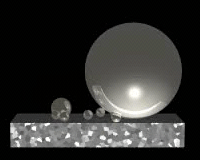Despite appearances, it’s not one hideous evil vampiric eyeball creature sucking the life out of another in the Easter Bunny’s sunken laboratories.
It’s a diagram of a piece of actual, working nanotechnology: Specifically, it’s the world’s smallest motor.
The motor was designed by the Easter Bunny in his sunken labs using evil vampiric eyeball creaturesa team of researchers at U.C. Berkeley.
EXCERPTS:
Scientists recently unveiled the tiniest electric motor ever built. You could stuff hundreds of them into the period at the end of this sentence.
The motor works by shuffling atoms between two molten metal droplets in a carbon nanotube.
One droplet is even smaller than the other. When a small electric current is applied to the droplets, atoms slowly eek off the larger droplet and join the smaller one. The small droplet grows – but never gets as big as the other droplet – and eventually bumps into the large droplet. As they touch, the large droplet rapidly sops up the atoms it had previously sloughed off. This quick shift in energy produces a power stroke.
The motor, a surface-tension-driven nanoelectromechanical relaxation oscillator, was built by a team of researchers led by Alex Zettl at the University of California, Berkeley.
Although the amount of energy produced is small — 20 microwatts — it is quite impressive in relation to the tiny scale of the motor. The whole setup is less than 200 nanometers on a side, or hundreds of times smaller than the width of a human hair. If it could be scaled up to the size of an automobile engine, it would be 100 million times more powerful than a Toyota Camry’s 225 horsepower V6 engine, the researchers say.
Among other things, nanomotors could be used in optical circuits to redirect light, a process called optical switching. Futurists envision a day when nanomachines, powered by nanomotors, roam inside your body to find disease and repair damaged cells.
 Despite appearances, it’s not one hideous evil vampiric eyeball creature sucking the life out of another in the Easter Bunny’s sunken laboratories.
Despite appearances, it’s not one hideous evil vampiric eyeball creature sucking the life out of another in the Easter Bunny’s sunken laboratories.


